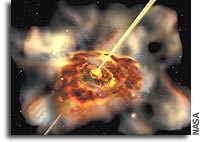Astronomers Glimpse Feeding of a Galactic Dragon

The most detailed view yet of the fuel that feeds a monstrous black hole in the center of a remote quasar galaxy has recently been obtained.
A team of radio astronomers has found a cold ring of gas around a supermassive black hole in the fiery nuclear region of quasar galaxy “QSO I Zw 1,” the most detailed observational evidence yet that gigantic molecular clouds fuel massive star formation in the galactic neighborhood of the black hole. A small fraction of this material might eventually find its way along streamers to the very center, just to be sacrificed to the black hole as fuel to power the brilliant quasar.
The ring of gas clouds is likely the site of intense star formation as the clouds collapse under their own gravity, according to the team, and the observation is a significant first step to determining if there is a link between star formation and quasar activity.
“Quasar galaxies are extremely remote, and this observation is at the limit of current capability,” said Dr. Johannes Staguhn, a radio astronomer with Science Systems and Applications, Inc. (SSAI) corporation, Lanham, Md., who is stationed at NASA’s Goddard Space Flight Center, Greenbelt, Md. Staguhn is the lead author of a paper on this research to be submitted to the Astrophysical Journal, and the work will be presented January 9 during a poster session at the 201st American Astronomical Society meeting in Seattle, Wash.
Quasars can outshine a trillion suns, and are believed to be the fiercely bright cores of galaxies that harbor black holes weighing in at millions to billions of suns. A black hole, so named because nothing, not even light, can escape its intense gravity once past its boundary, is suspected of being the engine that powers a quasar.
While many galaxies have massive black holes lurking in their centers, in quasar galaxies, the black holes “breathe fire” as they feed on vast amounts of interstellar gas that somehow makes its way into the galactic center. The gas whirls around the black hole before plunging in, like water down a drain. This generates intense friction, heating the gas and causing it to shine brightly.
The team selected QSO I Zw 1 for the challenging observation because although remote, it is still one of the closest quasars, at about 800 million light years away (in the direction of the constellation Pisces.) (One light year is almost 9.5 trillion kilometers, or about six trillion miles, and most quasars are billions of light years away.) The team used radio emission (108 GHz) from cold carbon monoxide (CO) molecules in the dense gas clouds of QSO I Zw 1 to map the location, density, and velocity of the clouds. Although quasars are dazzling in visible light, they are relatively dim in radio, so the observation was not washed out by the quasar’s glare.
The National Science Foundation’s Berkeley Illinois Maryland Association (BIMA) radio telescope array at Hat Creek, Calif., was used to make the observation because of its ability to resolve fine detail, called spatial resolution. The larger the telescope, the higher the spatial resolution, and the BIMA array links telescopes electronically (via interferometry) to achieve the effective resolution of a single telescope up to two kilometers (about 1.25 miles) across. The high resolution permitted the team to observe areas in QSO I Zw 1 less than a kiloparsec (3,260 light years) across, the first time detail at this scale has been seen in such remote objects. (A typical large galaxy, like our own Milky Way, is about 100,000 light years across.)
The ring of gas clouds is about 4,000 light years from the galactic center, rotating around it at about 200 kilometers per second (almost 125 miles/sec.), and contains the mass of more than a billion suns, according to the observation. Despite the unusual optical brilliance of the quasar, these are ordinary characteristics of luminous galaxies, according to the team.
Other observations indicate that QSO I Zw 1 is interacting with a neighboring galaxy. Observations of closer galaxies suggest that galactic interactions (collisions and near misses) cause bursts of star formation, and the team is curious about whether such interactions ignite quasar activity as well.
“We have hints that some of the cold gas clouds may be moving toward the galactic center, but since the observation is at the limit of the telescope’s capability, the signal to noise ratio is too poor to confirm this,” said Staguhn. “More detailed observations that will help determine if a link exists between bursts of star formation and quasars will have to wait for improved radio telescopes, like the proposed Atacama Large Millimeter Array.”
The research was funded by a grant from the National Science Foundation. The team includes Staguhn, Dr. Andreas Eckart of the University of Cologne, Germany, Dr. Eva Schinnerer of the National Radio Astronomy Observatory, Socorro, N.M., and Dr. Peter Teuben, University of Maryland, College Park.
For images and more information, refer to:
http://www.gsfc.nasa.gov/topstory/2003/0109quasar_galaxy.html









